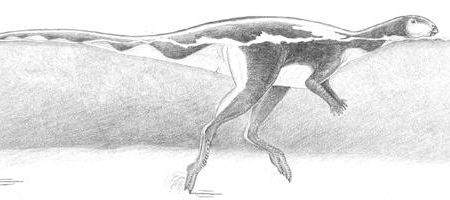The world’s only recorded dinosaur stampede shows the tracks of swimming rather than running animals, say University of Queensland researchers, representing clawmarks on a riverbed.

The thousands of small dinosaur tracks found 30 years ago at Lark Quarry Conservation Park date back between 95 and 98 million years. They are preserved in thin beds of siltstone and sandstone deposited in a shallow river when the area was part of a vast, forested floodplain.
“Many of the tracks are nothing more than elongated grooves, and probably formed when the claws of swimming dinosaurs scratched the river bottom. Some of the more unusual tracks include ‘tippy-toe’ traces – this is where fully buoyed dinosaurs made deep, near vertical scratch marks with their toes as they propelled themselves through the water,” says PhD candidate Anthony Romilio.
“It’s difficult to see how tracks such as these could have been made by running or walking animals. If that was the case we would expect to see a much flatter impression of the foot preserved in the sediment.”
He says similar-looking swim traces made by different sized dinosaurs also indicated fluctuations in the depth of the water, which seems to have ranged from about 14 cm to more than 40 cm.
“Unless the water level fluctuated, it’s hard to envisage how the different sized swim traces could have been preserved on the one surface,” he says.
“Some of the larger tracks are much more consistent with walking animals, and we suspect these dinosaurs were wading through the shallow water.”
The tracks belonged to small, two-legged herbivorous dinosaurs known as ornithopods. The large spacing between many consecutive tracks indicates that the creatures were moving downstream, perhaps using the current of the river to assist their movements.
Given the likely fluctuations in water depth, the researchers assume the tracks were formed over several days, maybe even weeks.
“Taken together, these findings strongly suggest Lark Quarry does not represent a ‘dinosaur stampede’,” Romilio said. “A better analogy for the site is probably a river crossing.”






